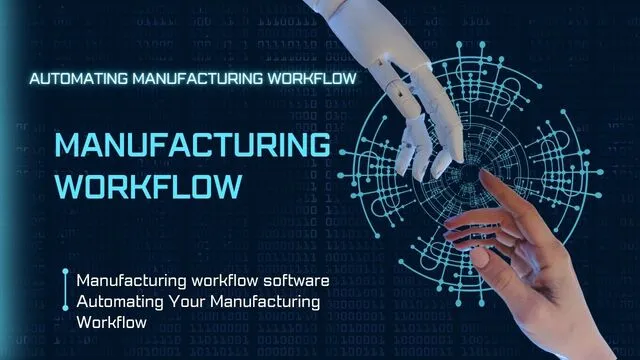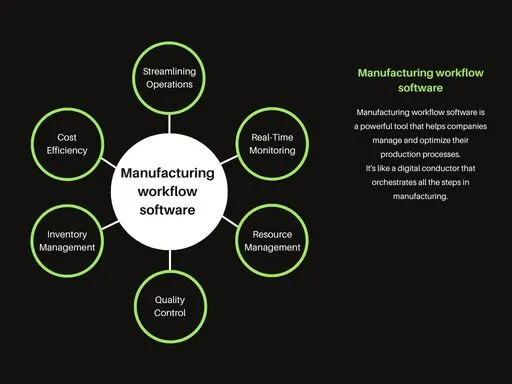What’s a Manufacturing Workflow
A manufacturing workflow is a step-by-step process that outlines how a product is created or assembled in a factory. It’s like a recipe for making things. This workflow breaks down the production into smaller tasks, showing who does what and when.

For instance, in making a car, the workflow might start with designing the car, then gathering materials like metal and glass, and finally assembling all the parts. Each step has specific instructions, and each person or machine involved knows their role.
Workflows help companies organize and streamline their production, making it more efficient and reducing mistakes. It ensures that the end product meets quality standards and is made on time. By following a manufacturing workflow, companies can make products faster, better, and more cost-effectively.
Different Types of Manufacturing Workflows
- Batch Production: In this type, a set number of identical items are produced in one go. For example, a bakery makes a batch of 100 loaves of bread.
- Mass Production: This is used to make a large number of identical products continuously, like car assembly lines that produce thousands of vehicles with the same specifications.
- Job Shop: In a job shop, different custom products are made, often in small quantities. It’s like a tailor creating unique clothing for each customer.
- Cellular Manufacturing: This approach groups similar machines and workers, making the production of a particular part more efficient.
- Lean Manufacturing: Focused on minimizing waste and optimizing efficiency. It aims to reduce excess materials, time, and resources.
- Just-in-Time (JIT): Products are made exactly when they’re needed, minimizing storage costs and waste.
- Continuous Flow: Used for items with high demand, like beverages. It’s a non-stop, high-speed production process.
- Discrete Manufacturing: It’s used for distinct, countable items. Think of a factory producing cell phones with various features.
- Process Manufacturing: Used for liquids, powders, and gases, where the ingredients blend, like in the production of chemicals or food.
Manufacturing workflow software
Manufacturing workflow software is a powerful tool that helps companies manage and optimize their production processes. It’s like a digital conductor that orchestrates all the steps in manufacturing.


Here’s how it works:
- Streamlining Operations: This software organizes and simplifies manufacturing steps, making it easier to track progress and manage resources. For instance, it can coordinate the assembly of smartphones by guiding workers on each step.
- Real-Time Monitoring: It provides real-time data on production. Just like a fitness tracker, it shows what’s happening at each moment in the manufacturing process. For example, it can track the temperature in a food processing plant to ensure food safety.
- Resource Management: It helps allocate resources efficiently. Think of it as a GPS for manufacturing. If a car manufacturer needs more tires in a specific assembly line, the software can reroute materials to meet the demand.
- Quality Control: Like a vigilant inspector, it checks products for defects. For instance, it can spot a flaw in a smartphone’s camera during the assembly process.
- Inventory Management: It keeps an eye on materials and parts, preventing shortages. Imagine a grocery store’s stock management system for manufacturing materials.
- Cost Efficiency: It optimizes costs by reducing waste and improving productivity. It’s like a financial advisor for manufacturing.
Manufacturing workflow software examples
Katana:
- Features: Real-time inventory tracking, production planning, and order management.
- Suitable for small to medium-sized manufacturers.
Fishbowl Manufacturing:
- Features: Inventory management, order management, and manufacturing automation.
- Integrates with QuickBooks for comprehensive business management.
Epicor ERP:
- Features: Comprehensive ERP solution covering various aspects of manufacturing, from production to supply chain.
- Suitable for medium to large enterprises.
JobBOSS:
- Features: Job shop and manufacturing process management, job scheduling, and materials tracking.
- Tailored for small to mid-sized manufacturers.
SAP S/4HANA Manufacturing:
- Features: End-to-end manufacturing solutions with real-time analytics and automation.
- Suitable for large enterprises with complex manufacturing processes.
Getting Started with Manufacturing Workflows
Starting with manufacturing workflows involves streamlining processes to enhance efficiency. Begin by mapping out your current processes, identifying bottlenecks, and understanding dependencies. Choose a suitable manufacturing workflow software that aligns with your business size and needs—consider options like Katana for small to medium-sized operations or Epicor ERP for larger enterprises.
Implement the software gradually, ensuring proper training for your team. Utilize features like real-time inventory tracking, production planning, and order management to optimize resource allocation. Monitor key performance indicators to assess the impact of workflow changes. Regularly review and adapt workflows to evolving demands, maintaining flexibility.
By adopting manufacturing workflow software and continuously refining your processes, you pave the way for increased productivity, reduced errors, and improved overall efficiency in your manufacturing operations.
Automating Your Manufacturing Workflow
- Assessment: Begin by evaluating your current manufacturing processes to identify repetitive tasks and areas prone to errors.
- Choose the Right Tools: Select automation tools tailored to your industry and production scale. Options like robotic process automation (RPA) or specialized manufacturing software can be effective.
- Integration: Ensure seamless integration of automation tools with existing systems. This prevents data silos and enhances overall connectivity.
- Training: Invest in employee training to familiarize the team with the new automated processes. This minimizes resistance and maximizes efficiency.
- Start Small: Implement automation gradually, beginning with smaller, manageable processes. This allows for smoother integration and adjustment.
- Monitor and Optimize: Regularly assess the automated workflows, monitoring performance metrics. Use data insights to refine and optimize the processes over time.
- Scalability: Choose automation solutions that can scale with your business growth. This ensures long-term relevance and adaptability.
By strategically automating manufacturing workflows, you streamline operations, reduce manual errors, and enhance overall productivity, positioning your business for sustained success.


I think, that you are not right. I can defend the position.
Thank you for sharing your perspective. I appreciate diverse opinions and am open to hearing your counterpoints. Could you please elaborate on the specific aspects where you disagree with the information provided in the blog post? This would allow for a more constructive discussion and help address any potential misunderstandings.
Your input is valuable, and I look forward to engaging in a thoughtful exchange of ideas.
Wow, awesome blog structure! How long have you ever been blogging for?
you made running a blog look easy. The full glance of
your web site is excellent, let alone the content material!
You can see similar: dobry sklep
and here najlepszy sklep